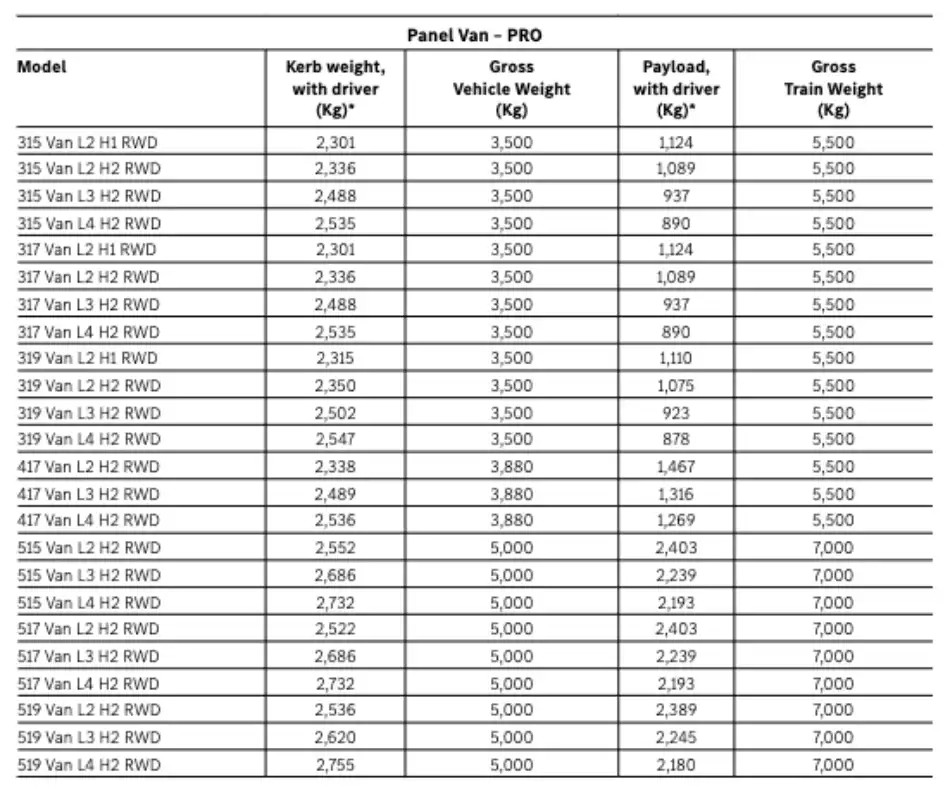Understanding the Mercedes-Benz Sprinter weight is crucial whether you’re a current owner, a prospective buyer, or simply managing a fleet. The Sprinter van has a long-standing reputation for versatility and capability, but navigating its various weight specifications can be confusing. This guide provides a clear and comprehensive breakdown of Mercedes Sprinter weights, payloads, and related terminology, drawing directly from manufacturer data to ensure accuracy.
Decoding Mercedes-Benz Sprinter Van Weight
The gross vehicle weight (GVW) of a Mercedes-Benz Sprinter van typically ranges from 3,500kg to 5,000kg. This figure represents the maximum permissible total weight of the van when fully loaded, including the vehicle itself, passengers, and cargo. It’s the most important weight specification to consider for legal compliance and safe operation.
To simplify understanding, Mercedes-Benz uses a numerical system in the Sprinter model name that subtly indicates the GVW. The first digit in the model number provides a quick reference:
- 3-series (e.g., 315, 317): These models are generally 3.5-tonne variants (3,500 kg GVW).
- 4-series: These indicate a GVW around 3.8 tonnes (3,800 kg GVW). Mercedes rounds up in this case.
- 5-series (e.g., 515): These are the heavier duty 5-tonne variants (5,000 kg GVW).
This numerical designation offers an initial clue about the van’s weight class, helping you quickly identify models suited to your needs.
Sprinter Van Variations and Weight Considerations
It’s important to recognize that the Sprinter is available in a multitude of configurations beyond the standard panel van. You’ll find Sprinters adapted into various body styles such as:
- Dropside: Open cargo bed with hinged sides.
- Flatbed: Completely flat, open cargo area.
- Tipper: Cargo bed that can be tilted to unload materials.
- Luton Van: Enclosed box body extending over the cab for increased cargo volume.
Each of these body variations will inherently affect the overall vehicle weight and consequently, the payload capacity. While providing precise weights for every custom Sprinter configuration is impossible due to the numerous body builders and bespoke adaptations, understanding the base van’s weight is the first step.
Understanding Sprinter Payload Capacity
Payload refers to the maximum weight a vehicle can legally carry, including cargo and passengers. The Mercedes-Benz Sprinter payload capacity varies significantly depending on the GVW rating and specific configuration.
The payload range for Mercedes-Benz Sprinter vans extends from 878kg up to 2,416kg. This broad range underscores the importance of checking the specific model’s details to determine its carrying capacity.
For the popular 3.5-tonne Sprinter models, the payload capacity typically falls between 878kg and 1,124kg. It’s crucial to note that as the GVW of a Sprinter increases, the payload doesn’t simply increase by the same increment. Mercedes-Benz engineers reinforce the heavier GVW models with stronger components to ensure durability and safety under heavier loads. This means a 3.8-tonne Sprinter, for example, won’t just offer 300kg more payload than a comparable 3.5-tonne version; the difference might be slightly less due to the added structural weight of the heavier-duty van.
Mercedes-Benz Sprinter Pro trim payload and weight specifications, detailing kerb weight and maximum carrying capacity for different models.
Choosing the Right Sprinter for Heavy Loads
If maximizing payload is your primary concern, the Mercedes-Benz Sprinter 515 L2H2 model stands out, offering a substantial payload capacity of up to 2,416kg. However, it’s vital to remember that as a 5-tonne GVW vehicle, operating a Sprinter of this weight typically requires a commercial driving license (C1 in many regions). Standard car licenses usually have weight restrictions that exclude vehicles over 3.5 tonnes.
For drivers holding a standard driving license, the Sprinter 315 L2H1 and Sprinter 317 L2H1 models are excellent choices. These 3.5-tonne variants still provide a respectable payload capacity of up to 1,124kg, balancing carrying capability with license compatibility.
Factors Influencing Sprinter Van Weight and Payload
Several factors can influence the kerb weight (unladen weight) and ultimately the payload capacity of a Sprinter van:
- Engine and Drivetrain: Engine type and size, along with transmission (manual or automatic), affect weight. Rear-wheel-drive (RWD) models, while often preferred for heavy-duty applications, generally have a slightly higher kerb weight than front-wheel-drive (FWD) versions due to the driveshaft and associated components.
- Trim Level and Optional Equipment: Higher trim levels and added options like air conditioning, advanced infotainment systems, and extensive load lining increase the kerb weight, consequently reducing the available payload.
- Body Type and Conversion: As mentioned earlier, different body styles significantly impact weight. Custom conversions and specialized bodies will further alter the base van’s weight.
The payload figures provided by manufacturers are typically based on a base specification model. Adding options or choosing higher trim levels will reduce the actual payload available.
Mercedes-Benz Sprinter Select trim payload specifications table, outlining the kerb weight and maximum payload for various models within the Select trim range.
Mercedes-Benz Sprinter Kerb Weight Explained
The kerb weight of a vehicle is its weight when empty, with standard equipment, and essential fluids (like oil and coolant) but without passengers or cargo. The Mercedes-Benz Sprinter kerb weight varies across the range, from 2,301kg to 2,755kg.
Within the 3.5-tonne Sprinter category, the kerb weight typically ranges from 2,301kg to 2,543kg. Knowing the kerb weight is useful for calculating the precise payload capacity for a specific vehicle. Payload is essentially calculated by subtracting the kerb weight from the GVW.
In conclusion, understanding the Mercedes-Benz Sprinter weight specifications is essential for safe loading, legal compliance, and choosing the right van for your operational needs. Always refer to the manufacturer’s specifications for the specific model and configuration you are considering to ensure accurate weight and payload information.
